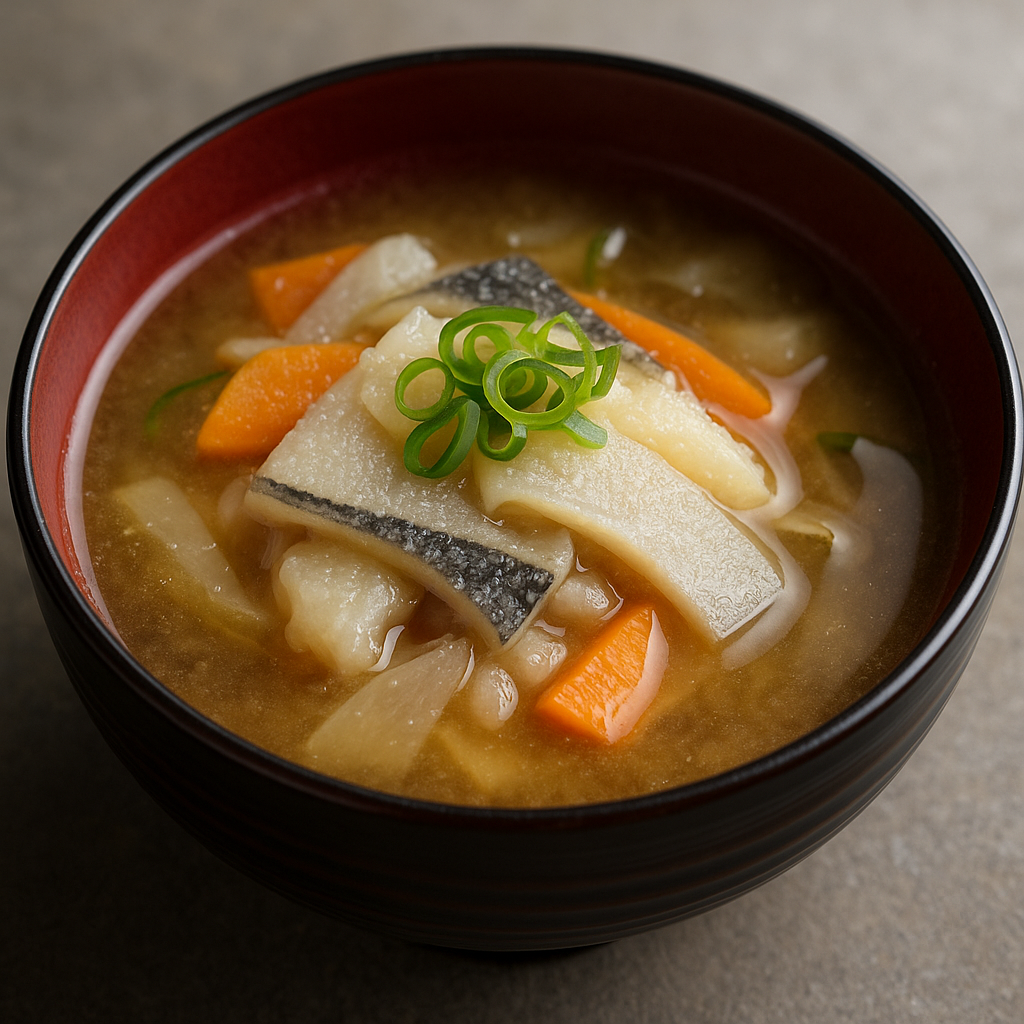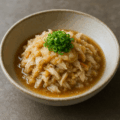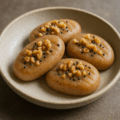くじら汁(青森)の特徴
塩くじらの脂で旨みを引き出す冬の郷土汁
青森の「くじら汁」は、塩蔵したクジラの脂身(塩くじら)をから煎りして脂を出し、根菜や寒大根、凍み豆腐とともに煮て味噌で仕上げる具だくさんの汁。香り高い脂と味噌の相性がよく、寒い季節に体が温まる一杯です。
八戸に根づく鯨食文化が背景
かつて八戸市に捕鯨基地があった歴史から周辺地域で鯨食文化が育ち、正月などの行事食としても親しまれてきました。
くじら汁のレシピ
材料(5人分の目安)
- 塩くじら(脂身) … 100g(薄い拍子切りまたは短冊)
- にんじん … 150g(ささがき)
- ごぼう … 100g(ささがき・水にさらす)
- 大根 … 120g(拍子切り)
- 味噌 … 適量(仕上げ用)
- 醤油 … 少々(味の微調整)
- 長ねぎ … 適量(小口切り)
- 水 … 適量(具がひたる程度)
作り方
- にんじん・ごぼうはささがきにして、ごぼうは水にさらす。大根は拍子切りに。
- 塩くじらは1.5mmほどの拍子切りまたは短冊にし、さっと水洗いして塩を流す。
- 大きめの鍋を温め、塩くじらを入れてから煎りし、脂を引き出す。
- にんじん→ごぼう→大根の順に加えてさっと炒め、具がひたる量の水を注ぐ。
- 野菜に火が通ったら味噌を溶き入れ、味を含ませる。
- 長ねぎを加え、好みで醤油少々で味を整える。
シェフのワンポイントアドバイス
塩くじらは「から煎り」で脂を出すのがコクの要。味噌は塩くじらの塩分に合わせて少しずつ調整を。
アクは序盤に取るだけにすることで、油分と旨味のコク、そして香りを堪能することが出来ます。
本格的な材料を揃えるのが難しい為、くじら以外は無難な材料にしてあります。
栄養価(1杯の目安)
- エネルギー:約220〜320 kcal
- たんぱく質:10〜18 g
- 脂質:10〜18 g
- 炭水化物:15〜30 g
※具材や味噌量により変動します。
歴史
鯨食文化と行事食
八戸周辺に根づいた鯨食文化のもと、塩くじらの脂身を活かした汁が冬のごちそうとして定着。正月の大鍋料理としても作られ、各家庭で具材や味付けに個性が受け継がれています。
English Version
Features of Kujira-jiru (Aomori)
A hearty winter soup that draws umami from salted whale fat
Aomori’s “Kujira-jiru” simmers salted whale blubber (shio-kujira) to render its fat, then cooks root vegetables and daikon with miso for a richly flavored, warming soup. The aromatic fat pairs beautifully with miso—perfect for cold weather.
Rooted in Hachinohe’s whale-eating culture
With Hachinohe’s historic whaling base, a local whale cuisine took hold and this soup became a festive dish for New Year and other occasions.
Recipe
Ingredients (serves 5)
- Salted whale blubber (shio-kujira) … 100 g (thin batons or strips)
- Carrot … 150 g (shaved/sasagaki)
- Burdock root … 100 g (shaved; soak in water)
- Daikon … 120 g (batonnet)
- Miso … to taste (for finishing)
- Soy sauce … a little (to fine-tune)
- Scallion … to taste (thinly sliced)
- Water … enough to just cover the ingredients
Instructions
- Prep vegetables: Shave the carrot and burdock (soak burdock in water). Cut daikon into batons.
- Rinse whale: Cut shio-kujira into ~1.5 mm batons or strips and quickly rinse to reduce surface salt.
- Dry-render: Heat a large pot and add the whale without oil to dry-render and draw out fat.
- Sweat & simmer: Add carrot → burdock → daikon, toss briefly in the rendered fat, then add water to just cover and simmer.
- Season: When vegetables are tender, dissolve in miso to taste and let flavors meld.
- Finish: Add scallion and adjust with a splash of soy sauce if desired.
Chef’s Tips
- Dry-rendering the shio-kujira is the key to deep flavor. Add miso gradually, accounting for the salt already in the whale.
- Skim only early on—leaving some fat keeps body and aroma.
- Because authentic ingredients can be hard to source, the vegetables are kept simple and reliable.
Nutritional Value (per bowl, approx.)
- Calories: ~220–320 kcal
- Protein: 10–18 g
- Fat: 10–18 g
- Carbohydrates: 15–30 g
*Varies by ingredients and miso amount.
History
Whale cuisine and ceremonial fare
Centered around Hachinohe’s whale heritage, a soup that makes the most of salted whale fat became a beloved winter treat. Prepared in big pots for New Year, households pass down their own choices of ingredients and seasoning.



何でも質問してください!